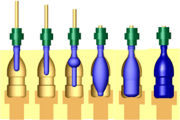Blow molding
From DDL Wiki
(→Process) |
(→Process) |
||
| Line 1: | Line 1: | ||
| - | = | + | ==Definition== |
Blow molding is used to manufacture hollow plastic parts, and can be performed via extrusion, injection or stretch processes. | Blow molding is used to manufacture hollow plastic parts, and can be performed via extrusion, injection or stretch processes. | ||
| + | ==Process== | ||
'''Extrusion blow molding (EBM)''' | '''Extrusion blow molding (EBM)''' | ||
| Line 21: | Line 22: | ||
[[Image:24-441_07_Team06_Inside_the_mold.jpg|thumb|The stretch blow molding process.]] | [[Image:24-441_07_Team06_Inside_the_mold.jpg|thumb|The stretch blow molding process.]] | ||
| + | |||
| + | ==Application== | ||
| + | |||
| + | ==Design Considerations== | ||
| + | |||
| + | ==External References== | ||
Revision as of 09:36, 12 February 2007
Contents |
Definition
Blow molding is used to manufacture hollow plastic parts, and can be performed via extrusion, injection or stretch processes.
Process
Extrusion blow molding (EBM)
Plastic is first extruded into a hollow tube (called a parison), which closes at one end when the melted plastic accumulates at the end of the barrel around which the tube is extruded. Then, this parison is captured in a metal mold where air is blown into the cavity, stretching the parison into the desired shape. Finally, the part is removed from the mold after sufficient cooling.
EMB can be continuous or intermittent. If it is continuous, blow molds may either rotate or shuttle with respect to a fixed extrusion head. In intermittent processes, the molds are stationary and the parisons are dropped into them.
Injection blow molding (IBM)
Least common, IBM begins by first injecting molten plastic or glass into a hollow mold containing a core rod. The outer mold is the removed, leaving the initial shape around the rod. Both are then clamped into a cooled blow mold, the rod is removed, and pressurized air creates the final shape. The part is removed from the mold.
Stretch blow molding (SBM)
Here, an initial form is also created. This shape is first placed within the neck of the final mold. The form is then stretched with a core rod with an initial air pressure of 70 to 350 psi, until the stretch rod reaches the bottom of the mold and pressure is increased to 580 psi.
This type is most preferable because it offers optimal structural and cosmetic advantages, especially in the case of withstanding forces of carbonated beverages. Also, there is no resulting flash, but only a line where the mold halves meet.

